Kei Tua o te Pae
Kei Tua o te Pae/Assessment for Learning: Early Childhood Exemplars is a best-practice guide that will help teachers continue to improve the quality of their teaching.
The exemplars are a series of books that will help teachers to understand and strengthen children's learning. It also shows how children, parents and whānau can contribute to this assessment and ongoing learning.
We are making improvements to our download-to-print functionality. So if you want a printed copy there are PDF versions available at the bottom of the main cover page.
Strategies for active exploration, thinking, and reasoning
-
What’s over the fence?
A journey: Discovering the past

0-HUIARANGI
Known also as Pigeon Mountain or Pigeon Tree Mountain.
An extinct volcano, which has been partially destroyed by quarrying.
Exploring our mountain. O-Huiarangi



Getting the feel of the mountain. Sliding on the steep slopes inside the rubbish bags.
Shooting down at speed on the slippery grass.

Climbing the old trees

The weight of the rocks!
- Making connections
- Asking questions
- Researching
- Investigating
Looking for answers that lead to new understandings.
My volcanoes



Matthew came to the centre with a big egg tray. He ran to show me and to tell me all about his volcanoes. I looked and every peak on the tray had an orange spot on the top and wriggly yellow lines running down the sides. Matthew explained to me that the lines on each volcano were the lava flows. I was so impressed! What thoughtful and creative work and no doubt influenced by the books on volcanoes that Matthew has been looking at all week.
Matthew was part of the group who walked to 0-Huiarangi this morning. When we came back I found him sitting at the table with his volcano tray and the stack of volcano books. He was waiting for someone to talk to and so I sat down beside him. He found the diagram of a volcano that shows the magma rising up through the core of the mountain and the discussion began!
He looked for photos of the orange lava running down the mountainside. Matthew asked me why the rock was running like that.
We talked about how hot it was and how heat melted the rock. He wanted to know where the lava had come from. After listening to my explanations of how hot the centre of the earth was he kept asking me, "Why can't we go down that hole?"
Short-term review
It was hard for him to accept just how hot the crater of the volcano was. Finally he pointed to the picture of the crater lake and the steam coming out of it and he laughed and he said, "I could cook my dinner in it!"
We giggled together. It was lovely to enjoy Matthew's joke at the end of a very intense learning situation.
Matthew was taking responsibility for his own learning. He knew what he wanted to research. He had already explored some ideas at home. He sought out an adult to help him. He understood about lava running down volcanoes and he was searching for the answers to his questions about why the rock was hot and melted and where had it come from. When he commented about cooking his dinner it seemed that he had accepted the heat that was coming from the crater but was still struggling to understand about the centre of the earth being so hot. I appreciated the humorous way he ended the session.
Inquisitive minds
Today we experimented again with making replica models of our mountain 0-Huiarangi.
Cameron was very keen to try again, because last time the sawdust dough we made became very thick and hard to mould.
Today we tried using finer sawdust.
Micah and Cameron became very focused on making their mountains straight away and I really enjoyed being with them as they shared their theories on the mountain. Revisiting the activity stimulated their thinking and they continued to develop what they knew about mountains.
Micah proclaimed, "I'm making the mountain when it used to be a volcano, because I was alive and I was very little, my brother was bigger and he used to walk to the rugby field."
Micah was very intrigued with the shells he had seen at 0-Huiarangi, and asked why were they there.
Cameron was able to answer that. He believes that there used to be a big stream, and it all 'drowned', and it is not there anymore, and the shells are left behind. (Great theory, Cameron.)
Micah liked that idea, and put it into his own words, "What is it when it all sinks into the ground?" he asked.
I tried to work through what word Micah was looking for; he talked a lot more and became happy with the words 'it soaks away'.
Micah also talked about the Māori people, and he asked, "Why did they just live there on the mountain and not down here where our houses are?"
Cameron focused on putting the shells on his volcano, and making the steps again. Micah still believes that he followed a path, not steps; but Cameron says he had to climb steps to get up to the top!
What next?
Micah is asking about why the Māori people lived on the mountain. Now that we have found out what is relevant to Micah and Cameron, we can find out how to answer their questions. It would be very useful to read our Māori legend books, so Micah can soak up some more information.

This is Micah's mountain.
Comment from Robyn.
We can find other ways for Micah to find out about early Māori villages and pa sites. We can return to 0-Huiarangi so that he can look more carefully and see the signs of early habitation and use Geoff Fairfield's book16 as a source of information. We can share this story with Micah's whānau so that together we can learn so much more.

This is Cameron's mountain.
Drawing 0-Huiarangi
Leah's story time had finished and the children were all looking at and discussing the shared drawing they had done to show Leah what our mountain looked like.
Suddenly they just had to draw their own, and they spread out onto the floor and began to draw the most amazingly detailed pictures of that awesome mountain 0 -Huiarangi.

Grace's amazing mountain with the big pohutukawa tree there on the edge of the drawing.

Matthew's carefully drawn mountain with the steps and the goal posts and the grass and that high, high mountain!


One of the questions the children asked was "Why are there shells on the mountain?"

Micah identified the shells as being like those he found at the beach.
Verity thought that long ago the beach might have been on the mountain.
Cameron suggested that there had been a river and when it dried up the shells may have been left behind.
Shells up mountains
Recorded by Robyn
Helen, Verity, Micah and I were having a conversation about Pigeon Mountain. Micah wanted to know why the Māori people chose to live on the mountain. When the older children revisit 0-Huiarangi next week he will be able to think hard about that and try to work out the answer.
Verity wondered why there were shells on the mountain. She suggested that the beach might have been up there. Micah suggested that the people may have carried the shells up the mountain and dropped them on the way. Then they began to wonder why the people would want to carry shells up there. We talked about the shells we had found at Cockle Bay. I told them that all shells had shellfish in them and Helen said that Maori people in particular really like to eat shellfish.
Micah said that the shellfish would live in the "mermaid" shells. Micah was referring to the cockle shells we had found at Cockle Bay. I remember him calling them "mermaid" shells. He said that the shellfish would live in them because they closed up and opened. He demonstrated with his hands how a "mermaid" shell opened and shut.
Helen and I were excited listening to these two asking questions and then drawing on their prior knowledge and past experiences to sort things out.
Verity wondered what it would be like to live in a shell. We decided that you wouldn't be able to get out or to walk anywhere. Micah thought that it would be very hot living in a shell. Helen reminded them that a shellfish can bury itself in the sand and come back up to the surface again.
What next?
I could bring some mussels to work so we could open them and see the shellfish inside and begin to talk about kai moana. There is a book in Te Reo about kai moana.
What an awesome conversation that was. I learnt so much about what these two are thinking about. Our visit to 0 -Huiarangi has given us the opportunity to learn so much about so many things.
We need to look at the book on Pigeon Mountain again and find out more about the Māori people who chose to live on 0-Huiarangi.
Helen worked with the group of children as they discovered more about kai moana.
This is Micah's drawing after discovering that the shells on the mountain were from the shellfish that the Māori people ate. He discovered that the shells were from the beach and that the people had dumped the empty shells in the rubbish piles - the middens.


Verity made the most wonderful starfish for the Māori people to have.
Evidence was gathering that the children understood the journey the shells had made from the beach to the mountain. There were people involved!
The reason behind why Māori people lived on top of 0-Huiarangi was explored and was compared to keeping ourselves safe in our homes. Jak commented that "You have to lock your house up when you go out." Discussion about the tall fences that they built around the pa drew comments from Jak that strangers would have to ask if they wanted to come in and Georgina added that they would have to say "Please". Matthew thought that they would need a large block to stand on to get over the fence and Jak suggested that throwing rocks might have some effect. Mt Wellington (Mangarei) was discussed in terms of the fact that the Māori people living on 0-Huiarangi would have had relatives that lived on Mangarei.
The children were also interested in looking at pictures in the book that depicted Māori people growing crops of food on the lower slopes of 0-Huiarangi.
Preparing to return to 0-Huiarangi
On Monday a group of four-year-olds: Georgina, Zain, Ryan, Gemma, Sarah, Jak, Amy and Matthew and I gathered to discuss the planned trip for the next day to again explore our local mountain. I read through the trip notice and the children placed the notice in their bags to give to their parents. We went over the questions and interesting points previously raised after our first visit to 0-Huiarangi. The book about 0-Huiarangi was a useful resource as I discussed with them how the shells came to be on the mountain. They enjoyed looking at the shell pictures taken some time ago on the actual mountain. Jak told me that he thought the Māori people lived on top of the mountain "cause they wanted to".
The child's voice
Child: Logan
Teacher: Kerri
Belonging
Mana whenuaTaking an Interest Today I had set the table with some interesting books we have on volcanoes.
Logan came over when he heard me talking to another child about our visit to 0-Huiarangi.
Logan began turning all the pages and finding all the pictures he liked.
He was telling me, "It's going to blow. It's going to blow."
I asked Logan, "How would we know when it blows?"
Logan replied, "The rabbits will go away." Logan then went back to finding the pictures he liked.


Well-being
Mana atuaBeing Involved Exploration
Mana aotūroaPersisting with Difficulty Communication
Mana reoExpressing an Idea or a Feeling Contribution
Mana tangataTaking Responsibility Short-term review
Logan's example of what he believes will happen if Pigeon Mountain explodes again is very true.
Logan is recalling his past experiences; when we visited Pigeon Mountain the first time we were told about wild rabbits.
We also hunted for them, as well as hunting for crater holes up the top of the mountain.
What next?
Logan is fascinated with volcanoes.
Logan becomes very excited when he talks about his volcano. There is so much we can do.
We can play with the playdough and use Geoff Fairfield's book to find out more information.
Logan really enjoys dramatic play. He might like to dress up as a rabbit, and we can re-enact Logan's perception of what happens when a volcano erupts.
Logan this is such an awesome drawing of Pigeon Mountain and Buzz Lightyear looks magnificent on top!
Logan was fascinated by the evidence of rabbits on Pigeon Mountain so I am not at all surprised to see the bunny there at the bottom of the page.

Child: Cameron
Teacher: Leah
A child's story
Belonging
Mana whenuaTaking an Interest Cameron was working alone at the play dough table. He made the volcano out of play dough, coloured plastic, and flat wooden sticks.
This is Cameron's explanation of his volcano:
He said, "Leah, when volcanoes get angry they would spit out hot lava all over the ground. The lava actually comes from this (pointing to the hole) and it is very hot. Actually all the trees around the volcano would be hot and will be burnt. It's just like the Pigeon Mountain story a long time ago."
l asked Cameron where he learnt about this story and he said, "Oh Kerri read the book before."
I asked him which book and he said, "Oh it's just there" (pointing to where the book is).
I went to the book corner and he said, "Oh, not there, it's here."
He gave me the book and showed me the picture of the Pigeon Mountain.


Well-being
Mana atuaBeing Involved Exploration
Mana aotūroaPersisting with Difficulty Communication
Mana reoExpressing an Idea or a Feeling Contribution
Mana tangataTaking Responsibility Short-term review
Cameron understood the Pigeon Mountain story that Kerri read to him a long time ago. He remembered that 0-Huiarangi (Pigeon Mountain) was surrounded by trees, and when the mountain erupted the trees would die. He was able to refer back to Geoff Fairfield's book and relate that information to the mountain he was making.
He is using different mediums (which he accessed independently) to express his understanding about volcanoes. He combined play dough, sticks, and red cellophane and used his imagination to represent them in his play.
Teacher's voice
After hearing his stories about the mountains and volcanoes, l also had a chance to share information about Mount Pinatubo in my country (the Philippines) when it erupted in 1991. I shared with him the stories that my mum told me on the phone. I told Cameron that there was total darkness when the volcano erupted. There were many people who lost their houses and families. Some trees, plants, and roads were covered with ashes.
Cameron asked many questions like "Why was there total darkness?" and "Why were the trees and roads covered with ashes?"
I managed to answer all his queries and had a fruitful sharing of information.
-
Sabine designs a swing
-
Child’s name: Sabine
Date: 30 January
Teacher: Shelley
Belonging
Mana whenua
Yesterday Sabine asked me to help her make a swing. She had seen one on High Five. Sabine described the swing that Charlie used to swing away. We found a hoop and hooked it up on the swing frame. It was not quite what Sabine wanted but it was time to finish so we decided to work on it the next day.
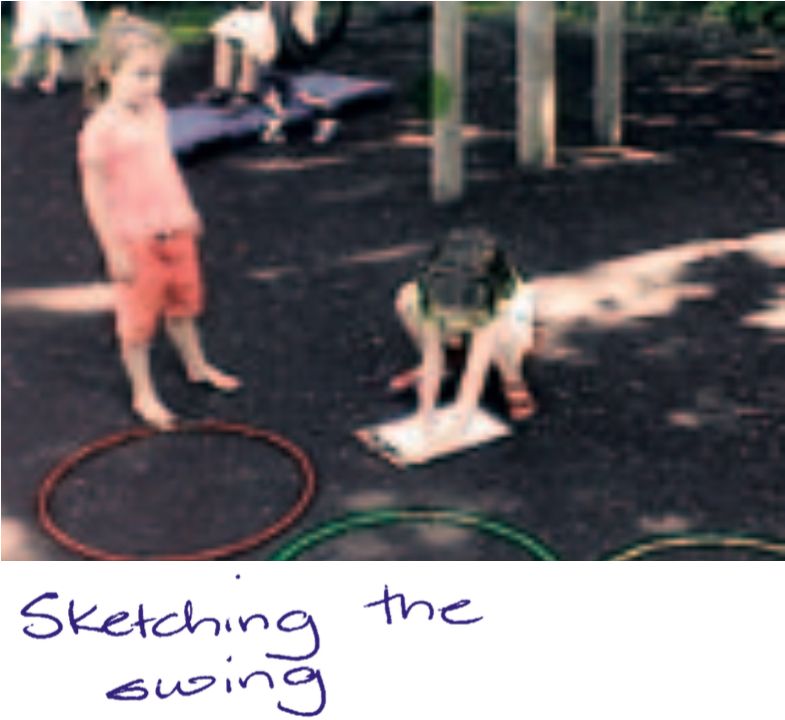
Today Sabine sketched the swing. We collected ropes, clips, and chains and experimented with heights.

Sabine wanted to be able to sit on it. She sat on the trapeze swing to measure how high she wanted it. We used the chain and clips. We then lowered it. Sabine then tried it but found it too low to swing upside down on. The swing went up again. Sabine and her friends tried this but Sabine went back to the original idea of what she wanted ... a swing to sit in and swing!
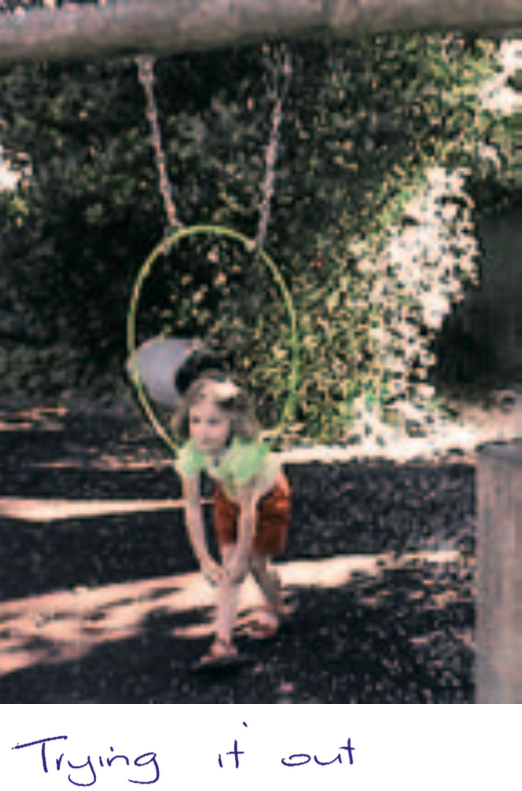
Down came the swing again until the level was just right. Then the hose was hard to sit on so we got some padding and stuck it on.
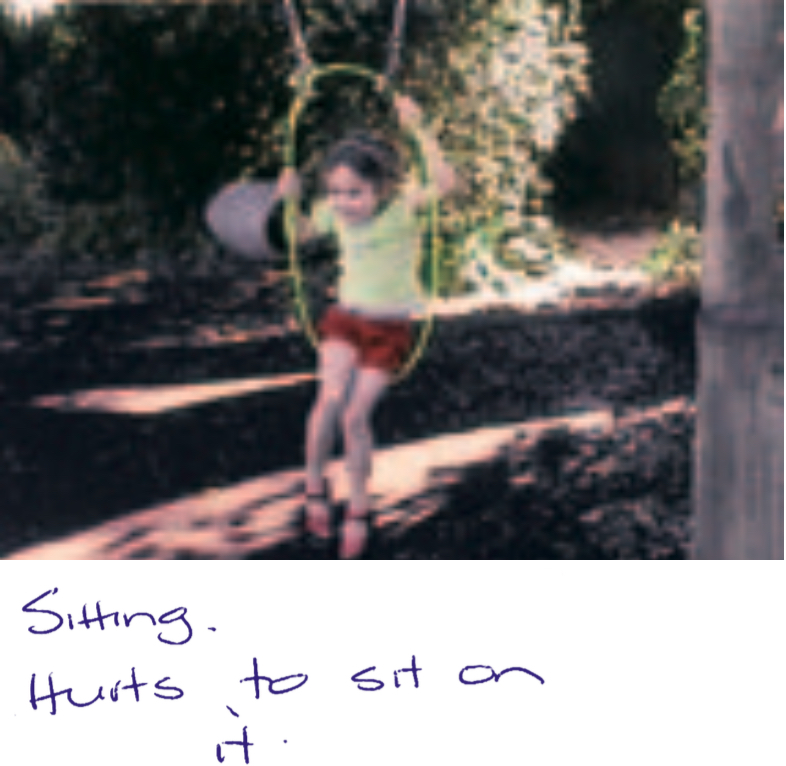
Sabine said, “Still hurts the side of my bottom” so we added more padding.
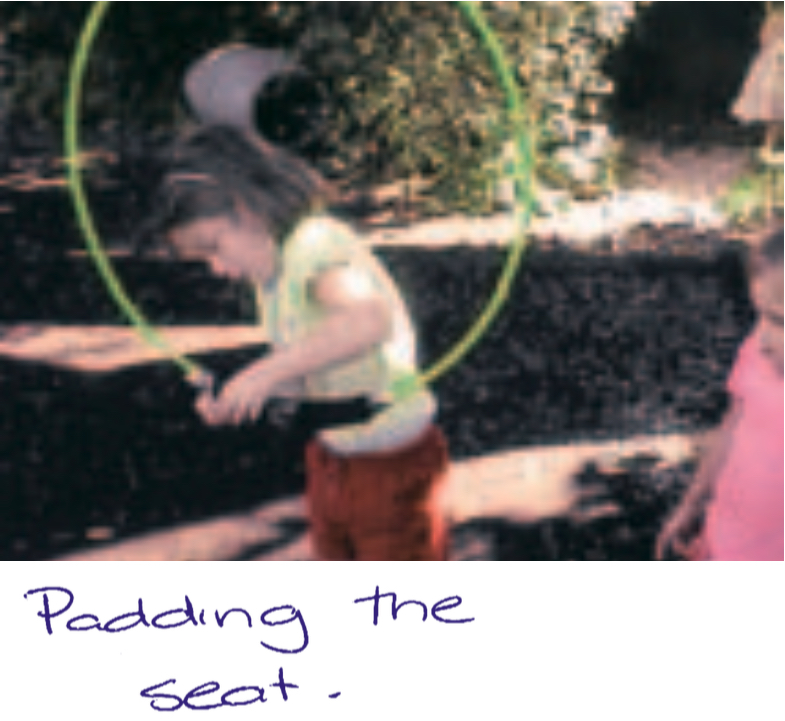
This was how she wanted the swing. We talked about how the swing went very narrow once they sat on it.
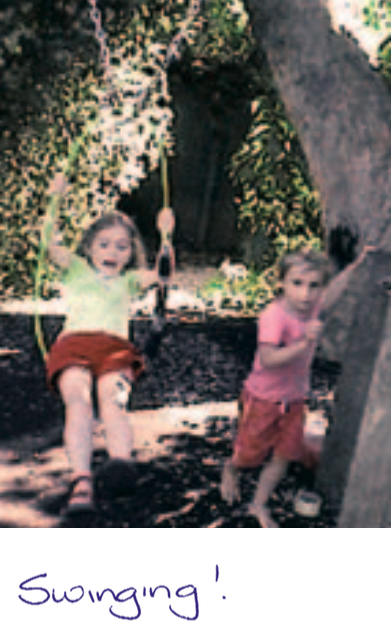
A final decision was made to put wood at the top. We measured how far the swing was from the top and how long the rope needed to be. The design was redrawn and faxed to Swings and Things to be made.
Well-being
Mana atuaExploration
Mana aotūroaCommunication
Mana reoContribution
Mana tangataShort-term review
Sabine was very clear about what she wanted. She experimented and eliminated what she did not want until the outcome matched her idea.
Very much in control with a keen audience. This motivated other children into thinking of swings and using the “Sabine swing”.
What next?
A new swing!!!!!!!
-
-
A budding archaeologist
-
Logan, knowing your interest in archaeology, I wanted to share a couple of my photos that I took in January at two archaeological sites near X’ian, in China.
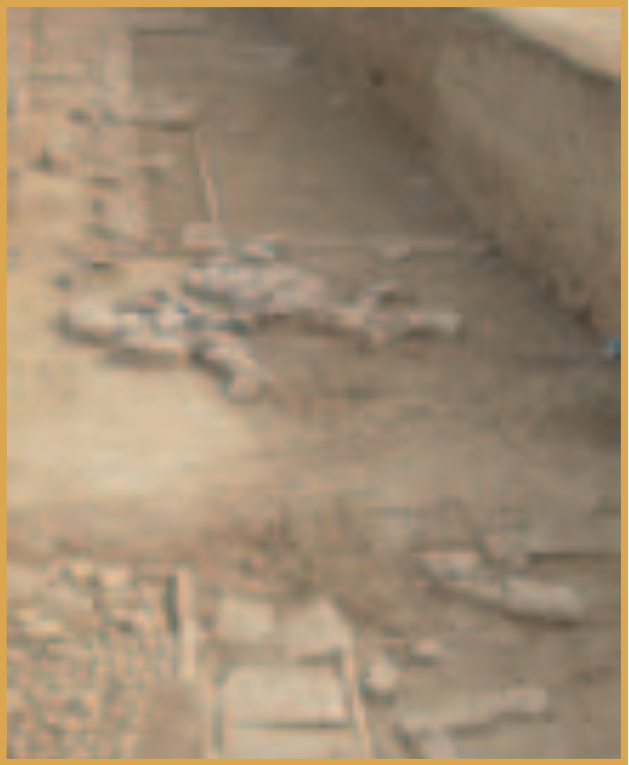
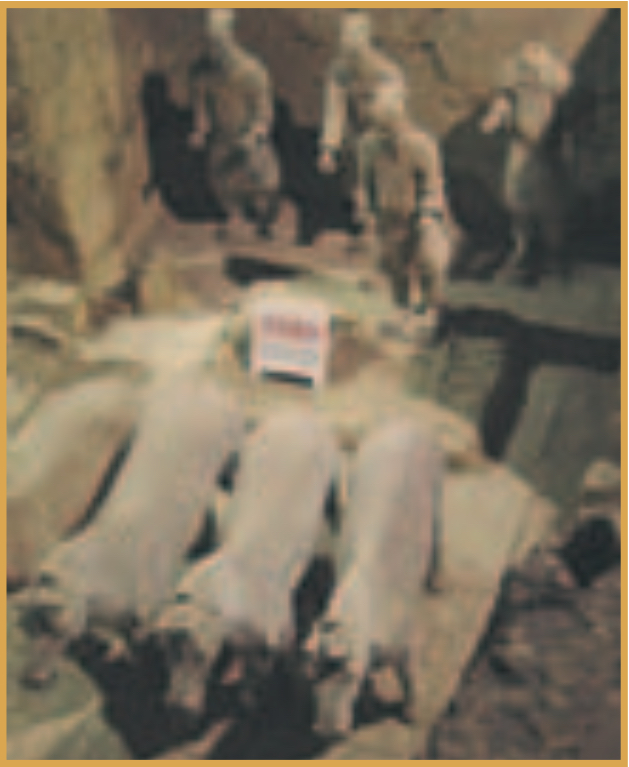
The first one is really old, and what they are finding dates back to 151 BC, still thousands of years after dinosaurs though, and the second is of the second digging site of the famous terracotta warriors. Both of these are active sites, and won’t be completed for many years. It’s really exciting and interesting, but to my knowledge, they have found a few human bones, but no dinosaurs or fossils.
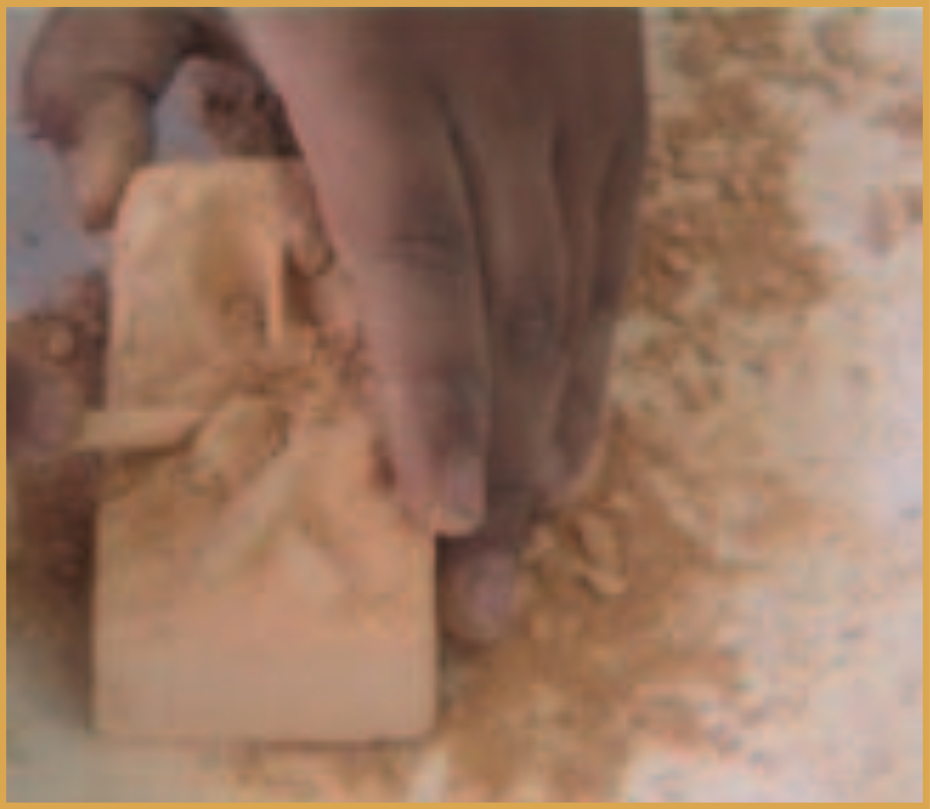
When I was looking around at the shop Nature’s Window at St Luke’s, I discovered these blocks with dinosaur bones inside that you have to dig out very, very carefully with a scraper and brush, just like the archaeologists in China, so you don’t damage the bones or whatever you are looking for in your dig, or archaeological site. As soon as I saw them, Logan, I thought of you and your love of dinosaurs and I remembered you saying that you wanted to be an archaeologist when you grow up.
You started this archaeological dig on Tuesday, 29 March. You were so excited as you started uncovering bones. When you discovered the second one, you called out and told me, “I’ve found another bone right over here. It’s a triceratops I think.” Your friend Matthew was really interested in what you were doing, and filmed some of this video footage before going to the science area to work with Joyce. After you had discovered another bone, which now made three, you took the slab over to show Matthew and Joyce.
I was really impressed with how patient and gentle you were being, and also how you explained to your friends what you were doing. This archaeological dig was taking a very long time, and by the end of the session you hadn’t completed it, so you had to continue the next day.
The next morning you arrived fresh and ready to go again. When you completed uncovering all the bones, they were covered in mud, so under your friend Ezekiel’s supervision, you scrubbed them very carefully in a bowl of water, using a cotton bud. You were very particular, working to get every scrap of dirt off, and Eze pointed out any specks that you had missed. After cleaning all the bones, but before you threw out your scrapings, you checked the bones by laying them on the table to make sure you had them all.
With all the pieces of the skeleton present and accounted for, you tried putting them together, but it was very frustrating as the legs and tail kept falling off. We tried to think of ideas that might solve this problem, and I suggested that using the glue gun to fix the bones together might do the trick. You thought that was a very good idea, and asked Jewels if she would help you.
When you finished it, you called to me, asking me to come and look at your triceratops skeleton. It was awesome, but looked a bit sleepy because it kept falling over, but you soon sorted out that problem by gluing it to a block of wood.
You were so proud of the result of all your hard work, and took it round the kindergarten to show everyone. You wanted everyone to be able to see your skeleton, but were worried that they might touch it and break it, so you asked if it could be put in the locked display in the science area. You did a great job Logan. We are very impressed with your knowledge and your eagerness to share it with all of us – thank you.

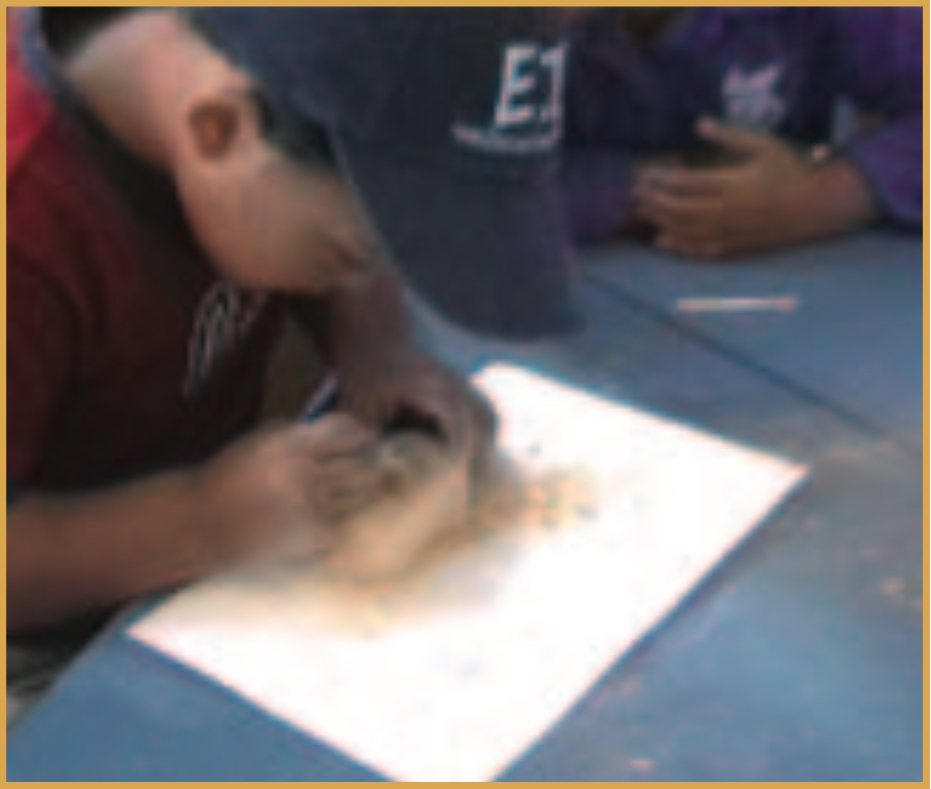
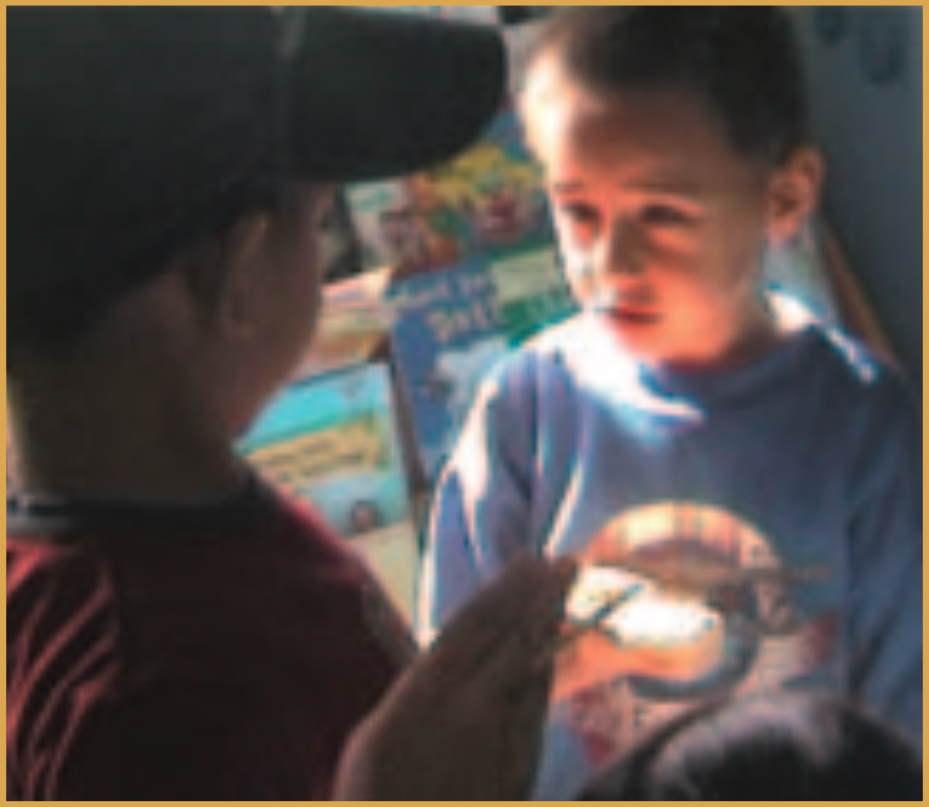
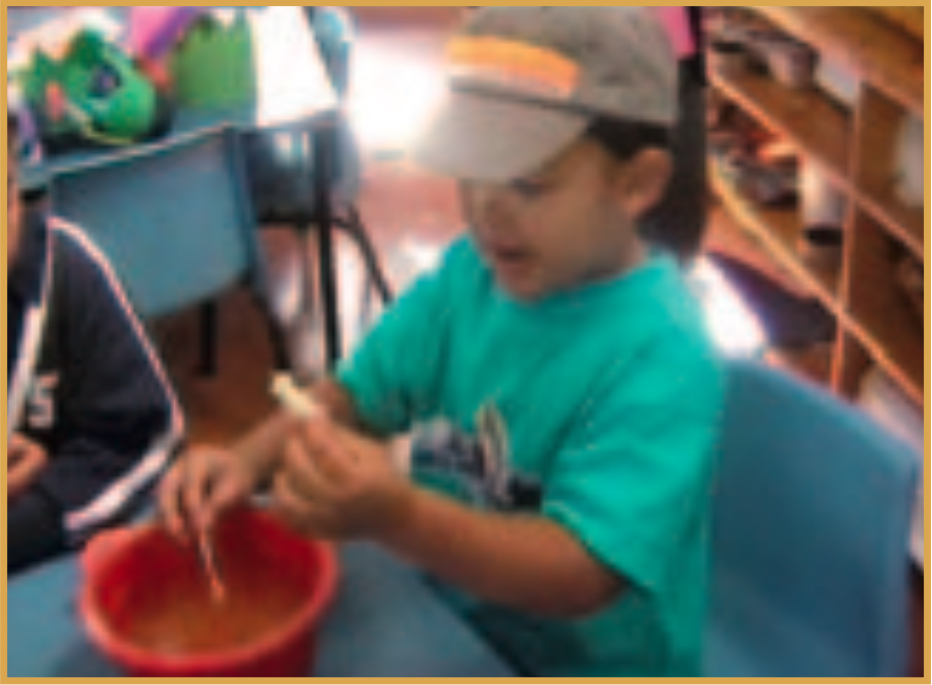
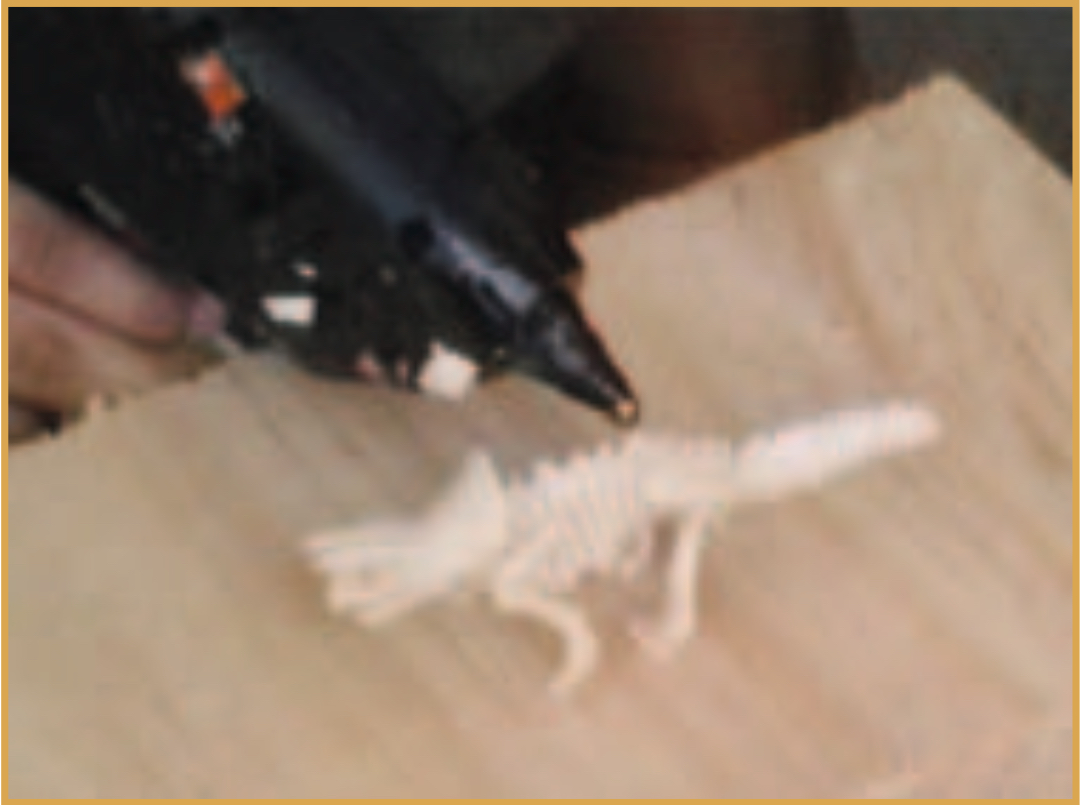
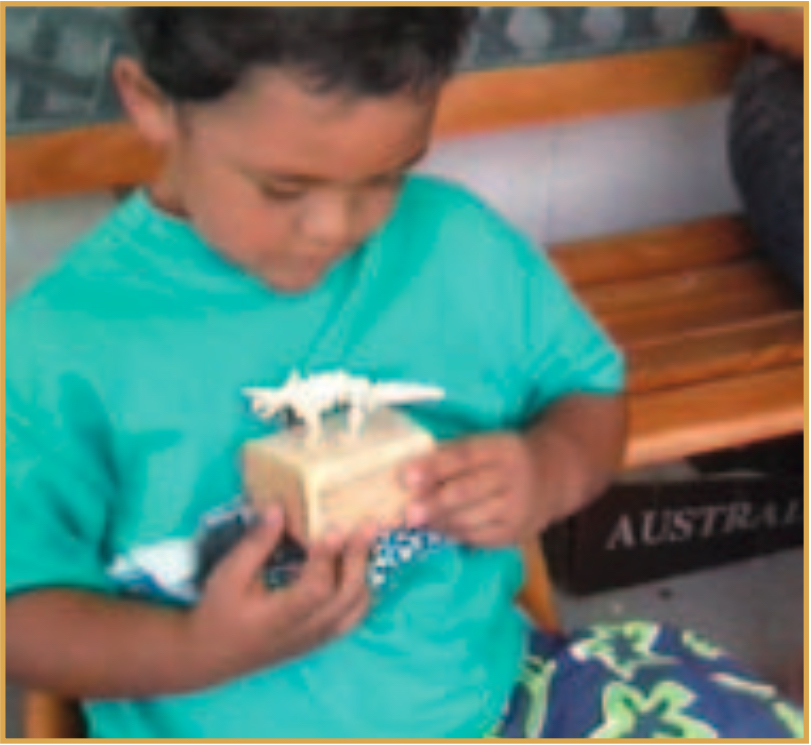
What learning has happened?
Through this activity Logan was able to practise some of the knowledge that he had gained from books and documentaries. Logan’s use of language while digging for the dinosaur bones was amazing, as was his prediction of the species of dinosaur very early in the dig. The manner in which Logan shared his knowledge during this activity was inspirational. It was at times similar to that of a lecture or documentary.
Logan discovered that, just as on a real archaeological dig, one has to be extremely gentle and careful, as he found the bones were very easily broken, after breaking one of the leg bones. He was very disappointed when this happened, and immediately slowed down and took much more care.
29 and 30 March
Teacher: Sally
-
-
"I thinked about it like this”
Luka was playing on the swings when he went to the shed and brought out the small sawhorse. He put it under the swing and used it to climb up to the wooden bar. He informed me that “I learned how to do this.” I asked him how he had learnt this. “I thinked about it like this, hmmm, and then I did this and that’s how I got up.” Luka showed me how he had tried to put the sawhorse underneath the swing. He showed me how he was thinking, by showing me how he screwed up his eyes and went “hmm”.
What learning is going on here?
I was very interested that Luka has an understanding of the learning process. He knows that this involves thinking about something and trying something out. He was able to self-assess this process, which is quite a complex thing to do. Often children are not able to articulate how they “know” something, but Luka is able to clearly explain this process. It is so exciting when children develop metacognition before they go to school as it helps them assess how to do things and what they need to do to learn something new.
Possibilities and opportunities
It was so cool that you could tell me about your learning, Luka. I can see that you tried to do something difficult and managed to do this. That shows great persistence. Being able to explain how you learnt to do something means you can show other children and be a great teacher. Thanks for showing me how you can climb up on the swing.
I was very impressed.
Alison, 27 July
Teaching and learning
Ronan asked me if I could lift him up onto the swing. I explained to Ronan that he could learn to do this by himself and that Luka would be able to help him as Luka had just learnt to do this the day before. Ronan went and found Luka who then demonstrated how to pull himself onto the swing. Ronan then had a go and Luka talked him through the process.
Within no time Ronan was swinging himself on the swing.
What learning is going on here?
Once again Ronan was able to seek help from an expert friend to acquire a new skill. With perseverance Ronan successfully achieved what he had set out to do. What a sense of achievement you must have felt, Ronan. I wonder what you will learn next?
28 July
Luka, the teacher
This week a few children have wanted to get up on the wooden bar swing. We have sent them to look for Luka to show them how to do it. Luka has gone through the process and explained what to do and waited and helped each child to get up on the swing.
Thank you for being such a great teacher, for sharing your expertise and helping other children learn how to do something new.
28 and 29 July
